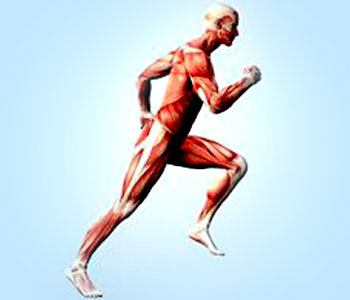 Contraction and relaxation of muscles
The muscles represented here are skeletal muscles. These muscles are consciously controlled by the brain. They move the body by contracting and relaxing, often in opposing pairs, which pulls tendons (white) attached to the skeleton. They account for about half the body's weight.
Contraction and relaxation of muscles
The muscles represented here are skeletal muscles. These muscles are consciously controlled by the brain. They move the body by contracting and relaxing, often in opposing pairs, which pulls tendons (white) attached to the skeleton. They account for about half the body's weight.
The contraction of voluntary muscles in all animals is because of the mutual sliding of two sets of interdigitating filaments: thick (containing the protein myosin) and thin (containing the protein actin) organized in sarcomeres. Voluntary muscle contraction is controlled by the central nervous system. The brain sends signals, in the form of action potentials, through the nervous system to the motor neuron that innervates several muscle fibers. In the case of some reflexes, the signal to contract can originate in the spinal cord through a feedback loop with the grey matter. Involuntary muscles such as the heart or smooth muscles in the gut and vascular system contract as a result of non–conscious brain activity or stimuli proceeding in the body to the muscle itself. During the process ATP (adenosine triphosphate) is hydrolyzed to ADP (adenosine diphosphate), the hydrolysis of ATP provides the energy.
For voluntary muscles, all contraction (excluding reflexes) occurs as a result of conscious effort originating in the brain. The brain sends signals, in the form of action potentials, through the nervous system to the motor neuron that innervates several muscle fibers] In the case of some reflexes, the signal to contract can originate in the spinal cord through a feedback loop with the grey matter. Involuntary muscles such as the heart or smooth muscles in the gut and vascular system contract as a result of non–conscious brain activity or stimuli endogenous to the muscle itself. Other actions such as locomotion, breathing and chewing have a reflex aspect to them: the contractions can be initiated consciously or unconsciously.